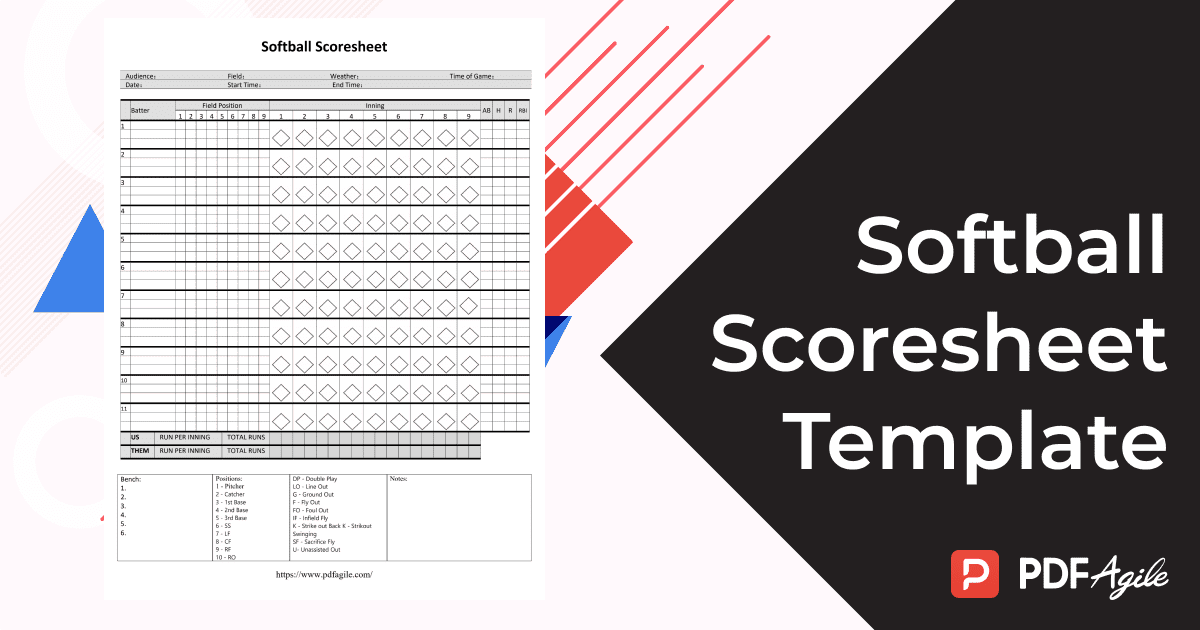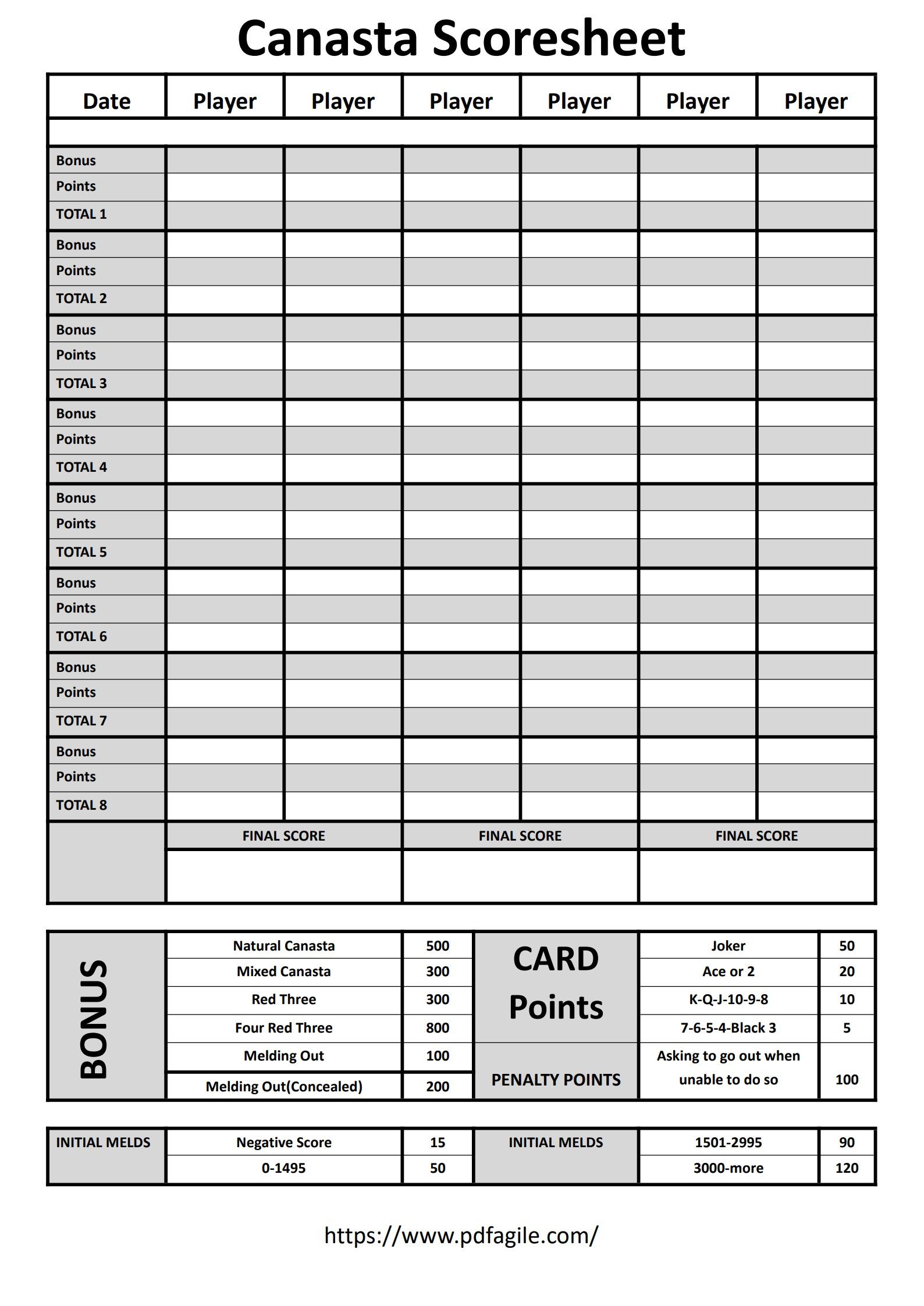The crack of the bat, the roar of the crowd, the thrill of a close play at the plate - softball is a sport brimming with excitement. But amidst the action, a silent hero keeps track of every out, every run, and every strategic move: the scoresheet.
This unsung champion isn't just about recording the final score. It's a detailed map of the game's narrative, capturing the individual contributions of players and the ebbs and flows of the competition. Whether you're a seasoned player, a curious spectator, or a coach seeking insights, the scoresheet is your key to unlocking a deeper understanding of the game.
This guide delves into the world of the softball scoresheet, explaining its purpose, its basic format, and how to use it effectively. We'll explore the benefits of maintaining a clear scoresheet, from ensuring accurate scorekeeping to tracking player performance and enhancing the overall game experience. So, grab your pen or digital device, and let's embark on a journey to master the art of softball scorekeeping!
What is a Softball Scoresheet?
In the heat of a close softball game, every out, every run, tells a story. But how do you capture that story, ensure accuracy, and track individual performances? That's where the unsung hero, the softball scoresheet, steps up to the plate.
Here's what a softball scoresheet is, in a nutshell:
- The Official Record Keeper: It's the game's official document, chronicling every play, hit, and run. It ensures both teams have a clear record of the events and final score.
- A Visual Representation of the Game: The scoresheet provides a play-by-play breakdown, inning by inning. This allows players, coaches, and spectators to follow the game's progress, understand crucial moments, and appreciate individual contributions.
- More Than Just Paper: While traditional paper scoresheets are common, the digital age offers alternatives. Digital scorekeeping apps can automate updates, provide visual representations of the game, and even generate basic player statistics.
In essence, the softball scoresheet is your on-field diary, capturing the story of the game for post-game analysis, record-keeping, and sometimes, just reliving the thrill of a close play or a game-winning hit.
Benefits of Using a Softball Scoresheet
The softball diamond is a battlefield of athleticism and strategy. But amidst the crack of the bat and the roar of the crowd, a silent hero keeps track of it all - the scoresheet. Here's how a well-utilized scoresheet goes beyond simple scorekeeping:
- Accuracy Under Pressure: Close games can be nail-biters, with every out and run crucial. A clear scoresheet minimizes confusion by meticulously recording each play (outs, runs, hits) for precise final scorekeeping. This ensures there are no arguments later, allowing everyone to celebrate (or commiserate) with confidence.
- A Player's Performance Report: Beyond the final score, the scoresheet unveils individual contributions. Batting statistics like at-bats, hits, and RBIs offer insights into a player's offensive performance. Did they consistently make contact? Drive in runs? This data becomes invaluable for coaches to identify strengths and areas for improvement, helping players refine their skills.
- Enhanced Game Engagement: The scoresheet isn't just for the official scorer. It provides a visual representation of the game's progress, keeping everyone invested. Players can track their team's performance inning by inning, while coaches can strategize based on the recorded data. Spectators, too, can follow the game's flow and appreciate individual plays in the context of the overall score.
- Building an Official Record: In official tournaments, the scoresheet transcends the game itself. It becomes the official record of the competition. This documented history ensures fair play and provides a verifiable account of the game's details, particularly in the case of disputes or for future reference.
Softball Scoresheet Basic Format
The softball scoresheet is your on-field encyclopedia, capturing the game's narrative inning by inning, play by play. Understanding its layout is crucial for accurate record-keeping and insightful analysis. Here's a breakdown of its essential sections:
- Game Information Section: This is the title page of your diamond diary. It should prominently display:
- Teams Playing: Clearly identify the two teams competing, ensuring no confusion throughout the game.
- Date and Location: Capture the when and where of the game for future reference or record-keeping.
- Starting Lineups: List each team's batting order and corresponding defensive positions (pitcher, catcher, etc.). This provides a quick reference for tracking player performance and understanding defensive alignments.
- Inning by Inning Section: This is the heart of the scoresheet, a detailed log of the game's progression. Here's what you'll typically find:
- Inning Row Headers: Each row represents a specific inning of the game (typically 1 to 7).
- Outs Made Columns: Dedicated columns track the number of outs made by each team during that inning. This is crucial for determining the end of an inning and keeping track of the game's overall progress.
- Runs Scored Columns: Separate columns record the runs scored by each team in each inning. This allows for calculating the game's score at any point and identifying offensive surges.
- Batting Statistics Section: For a more comprehensive picture of individual player performance, some scoresheets include a dedicated section for batting statistics. This might include:
- At-Bats: Tracks the number of times a player comes to bat throughout the game.
- Hits: Records the number of successful hits a player achieves.
- Runs Batted In (RBI): Captures the number of runs a player's hit directly leads to.
- Strikeouts: Tracks the number of times a player strikes out while batting.
- Fielding Statistics Section: For advanced statisticians, some scoresheets offer a dedicated section for tracking individual fielding plays. This might include:
- Putouts: Records the number of times a fielder directly records an out (catching a fly ball, forcing a runner out at a base).
- Assists: Captures the number of times a fielder contributes to an out by throwing the ball to another fielder for a tag or force out.
- Errors: Tracks the number of misplays by a fielder that allows the opposing team to advance a base or score a run.
- Game Summary Section: This section ties the game together in a neat package. It typically includes:
- Final Score: Clearly displays the final score of the game, with each team's score prominently displayed.
- Winning Team: Identifies the victorious team for the record.
How to Use a Softball Scoresheet?
The softball scoresheet is your on-field encyclopedia, capturing every play and keeping the game's story alive. Here's a step-by-step guide to ensure it reflects the action accurately and efficiently:
Before the Game:
- Gear Up: Designate a scorekeeper (ideally someone familiar with softball terminology) and ensure they have a well-organized scoresheet (paper or digital app).
- Set the Stage: Fill in the game information section - teams playing, date, location, and starting lineups (batting order and fielding positions). This provides context for the plays to come.
During the Game:
- Play-by-Play: As the game unfolds, the scorekeeper meticulously documents each inning in the designated section. Here's how to break it down:
- Outs: Record each out made (fly out, strikeout, ground out) using standard symbols or abbreviations (e.g., F, K, GO). Keep track of the out count for each half-inning.
- Runs Scored: Whenever a player crosses home plate, mark a run for their team in the corresponding inning section. Be clear about RBIs (Runs Batted In) if your scoresheet allows for it.
- Key Events: Capture other crucial moments that influence the game's flow. This might include walks (BB), stolen bases (SB), errors (E), or hits (single, double, triple, homerun) denoted by their corresponding symbols.
- Batting Bonanza: For a more detailed picture, some scoresheets include a batting statistics section. Here, you can track individual player stats like:
- At-Bats (AB): Every time a batter faces a pitch and doesn't walk or get hit by a pitch.
- Hits (H): Any safe hit that allows the batter to reach base.
- Runs Batted In (RBI): The number of runs scored as a direct result of a batter's hit (excluding home runs).
- Strikeouts (K): Record these for a more complete picture of a batter's performance.
- Fielding Finesse: Advanced scorekeepers can leverage a dedicated fielding statistics section to track individual defensive plays:
- Putouts (PO): A fielder directly records an out (catching a fly ball, tagging a runner).
- Assists (A): A fielder participates in recording an out by throwing the ball to another fielder for a tag or force out.
- Errors (E): A misplay by a fielder that allows a runner to advance or the batter to reach base safely.
After the Game:
- The Final Tally: Once the game concludes, record the final score for each team in the game summary section. Highlight the winning team for clarity.
- Optional Extras: Include any additional notes that might be valuable for future reference, such as weather conditions or a particularly game-changing play.
Tips for Using a Softball Scoresheet
The softball scoresheet is your on-field companion, capturing the drama of every out and the thrill of every run. Here are some tips to ensure it becomes a reliable tool, not a source of confusion:
- Know Your ABCs (and Xs): Familiarize yourself with common softball terminology before the game. Understanding terms like "out," "hit," "walk," and "error" allows for accurate and efficient recording of game events on the scoresheet.
- Double Play, Double Check: Don't let the fast pace of the game cloud your judgment. After each play, take a quick moment to review your notations on the scoresheet. Did you mark that out correctly? Did you capture all the details of that close play at first base? A quick double-check minimizes errors and ensures the scoresheet reflects the game accurately.
- Clear Communication is Key: Uncertain about a call or a play unfolding on the field? Don't hesitate to communicate with the umpire or other officials for clarification. A quick question can prevent a misunderstanding and ensure your scoresheet accurately depicts the game's events.
- Keep it Neat and Organized: Maintain a clear and organized format on your scoresheet. Write legibly, avoid clutter, and consider using abbreviations for common terms (e.g., K for Strikeout, BB for Walk) to save space. This clarity minimizes misinterpretations and allows for easier review of the game's progress later.
- Enjoy the Game: While accurate scorekeeping is important, softball is ultimately about competition, teamwork, and the joy of the sport. Don't get bogged down in meticulous record-keeping to the point of missing the excitement and camaraderie on the field. Relax, focus on the game, and let the scoresheet be a valuable record of your softball journey.
Free Download: Printable Software Scoresheet Template
To help you get started, we have created a free, printable software scoresheet template. You can download the template by clicking the Use Template button on this page.
You can also explore more scoresheet PDF templates in PDF Agile Templates Center.





